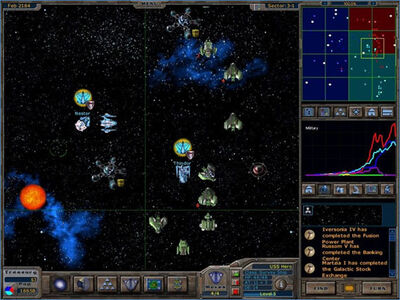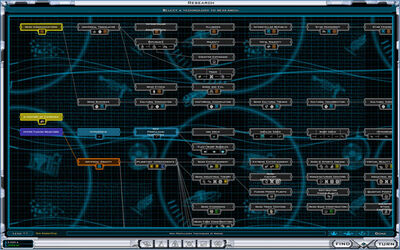Introduction[ | ]

While hanging out on Usenet's comp.sys.ibm.pc.games.strategic in 1992, college student Brad Wardell was just one of many Usenet participants who put together wish lists for their favorite games. Rather than sit in chat rooms all day, Brad decided to do something about his wish list. He would make his own game. One problem – Brad didn't really know how to program (other than some Basic) and was a poor artist. With little money, Brad bought "Teach Yourself C in 21 days" and decided to program the game for IBM's new OS/2 2.x operating system.
OS/2 had two features that Windows lacked: multithreading and memory protection. These allowed Brad to make a game with a robust computer AI. While most games forced the user to sit and wait for the computer players to plan and execute their strategies after each player turn, Galactic Civilizations would be multithreaded – its computer players would plan their strategy while the player moved their units. As a result, the computer players were significantly more clever and sophisticated than other games at the time.
Galactic Civilizations was probably the first retail game that made use of multiple threads (the second retail game to make use of multiple threads was called Avarice, also released by Stardock and developed by Dave Pottinger, who went on to become the lead developer of Age of Empires III for Ensemble).
As primitive as Galactic Civilizations for OS/2 might have appeared, at the time, PC games typically were only 320x200 with 256 colors. By contrast, Galactic Civilizations natively supported 1024x768 with 16.8 million colors. Stardock released an expansion for Galactic Civilizations for OS/2 called Shipyards which allowed users to design their own ships.
GalCiv OS/2[ | ]

In 1995, Stardock released a sequel to Galactic Civilizations (Galactic Civilizations 2) which improved the production values but was largely the same game. Galactic Civilizations 2 Gold was eventually released with updates and fixes that would be in a patch today; this was during the age where major updates couldn't easily be distributed electronically.
Galactic Civilizations 2 started to incorporate somewhat better artwork as seen with diplomacy screen.
GalCiv[ | ]

By 1997, OS/2 had clearly lost to Microsoft Windows in the battle for the PC desktop. Stardock began migrating its development efforts to Windows and made a number of small Windows games such as The Corporate Machine. Stardock kept its finger in the game industry pie with projects such as Starcraft: Retribution developed for GT Interactive & Blizzard Entertainment.
Stardock was finally able to revisit Galactic Civilizations in 2001, and it would take an additional two years for the game to be released.
As Galactic Civilizations was approaching completion, Atari informed Stardock that Master of Orion 3 would be released near the same time. The two companies cooperated on the release schedule in order for them to not directly compete. Stardock moved its ship date so that Master of Orion 3 could be released first, and axed the Shipyards (ship design feature). In return, every box of Master of Orion 3 came with a coupon promoting the relatively unknown Galactic Civilizations.
GalCiv II[ | ]

While Galactic Civilizations was a commercial success, its publisher, Strategy First, filed bankruptcy without having paid most of the royalties it owed. Luckily, most of Stardock’s revenue came from its software business and the company was able to fund a sequel without relying on the revenue from the Windows version of Galactic Civilizations.
The sequel, however, would be published by Stardock and move to a full 3D engine.
Like with Galactic Civilizations for Windows, Galactic Civilizations II would have its own set of mockups.
Galactic Civilizations II was an immense success. Players enjoyed designing their own ships and seeing how they made out against a devious AI. The ship designer
The game saw two expansions. The first, Dark Avatar, added asteroid fields, mining and numerous other features to the base game. The second expansion, Twilight of the Arnor, overhauled the graphics engine and provided each civilization with its own unique technology tree and ship parts.
The 3D engine was designed to scale with resolution thanks to heavy use of vector graphics within the game assets. As a result, even today on a 4K monitor, Galactic Civilizations II looks stunning.
For example, 2560x1440 was unknown as a gaming resolution during Galactic Civilizations II’s development in 2005. The game’s vector-based UI system (based on Stardock’s own DesktopX technology) could scale to handle it, however. This is most obviously seen with the research tree.
As a result, sales of Galactic Civilizations II have remained high since release, regularly peaking into the Steam top 10 even as recently as 2013.
GalCiv III[ | ]
It would take a long while for Stardock to get back to the Galactic Civilizations universe.
After the success of Galactic Civilizations II, its top developers worked on Impulse, a digital distribution platform, while a new generation of developers joined Stardock to work on Twilight of the Arnor and then Elemental: War of Magic.
Following the sale of Impulse to GameStop, the Galactic Civilizations team was reunited. They developed Elemental: Fallen Enchantress and then began work on Galactic Civilizations III.
Due to the expected longevity of Galactic Civilizations III, the new engine is strictly 64-bit and DirectX 11. This is to allow the game to continue to be improved and expanded well into the future.
Timeline[ | ]
- 1992 - College student Brad Wardell begins writing Galactic Civilizations for OS/2
- 1993 - Galactic Civilizations Beta 1 released
- 1994 - Galactic Civilizations released for OS/2
- 1995 - Galactic Civilizations 2 released
- 1996 - Galactic Civilizations Gold released
- 2003 - Galactic Civilizations for Windows released
- 2004 - Galactic Civilizations: Altarian Prophecy Released
- 2006 - Galactic Civilizations II released
- 2007 - Galactic Civilizations II: Dark Avatar released
- 2008 - Galactic Civilizations II: Twilight of the Arnor released
- May 2015 - Galactic Civilizations III!